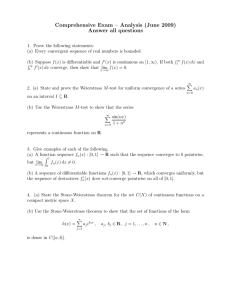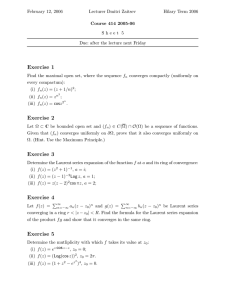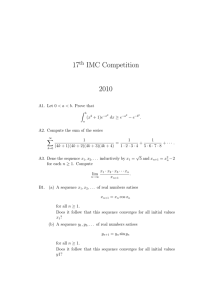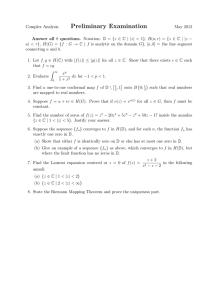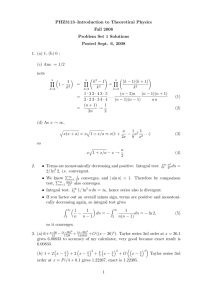Problem Set Seven: Uniform Convergence be a function, and
advertisement
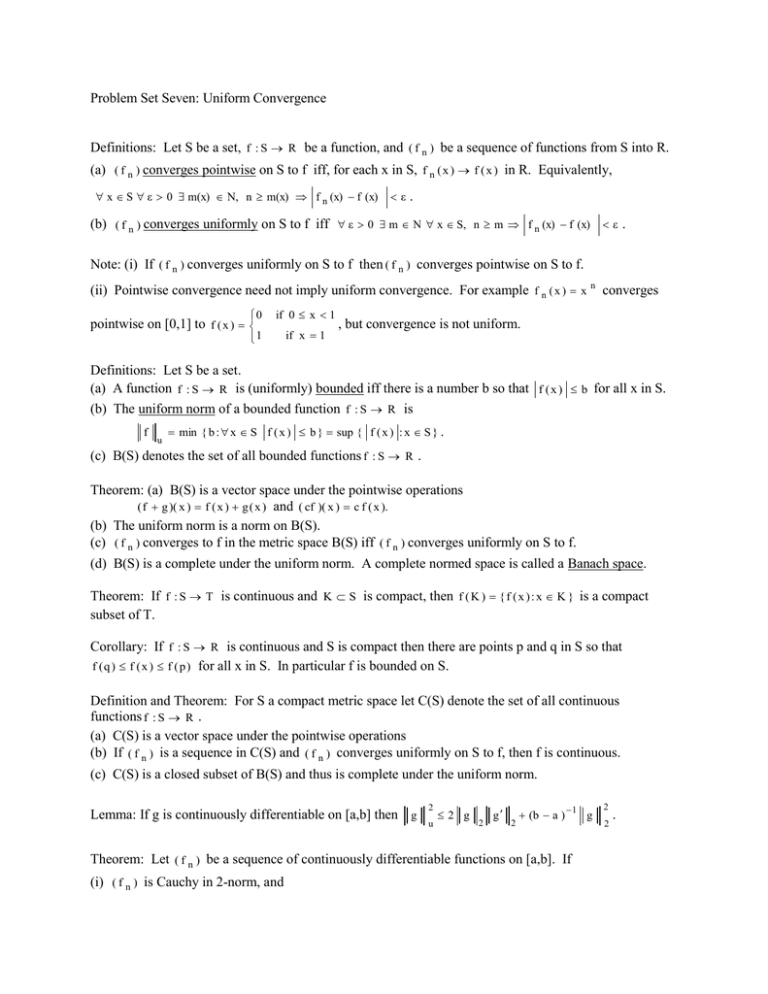
Problem Set Seven: Uniform Convergence
Definitions: Let S be a set, f : S R be a function, and ( f n ) be a sequence of functions from S into R.
(a) ( f n ) converges pointwise on S to f iff, for each x in S, f n ( x ) f ( x ) in R. Equivalently,
x S ε 0 m(x) N, n m(x) f n (x) f (x)
ε.
(b) ( f n ) converges uniformly on S to f iff ε 0 m N x S, n m f n (x) f (x) ε .
Note: (i) If ( f n ) converges uniformly on S to f then ( f n ) converges pointwise on S to f.
(ii) Pointwise convergence need not imply uniform convergence. For example f n ( x ) x n converges
0
if 0 x 1
1
if x 1
pointwise on [0,1] to f ( x )
, but convergence is not uniform.
Definitions: Let S be a set.
(a) A function f : S R is (uniformly) bounded iff there is a number b so that f ( x ) b for all x in S.
(b) The uniform norm of a bounded function f : S R is
f
u
min { b : x S f ( x ) b } sup { f ( x ) : x S } .
(c) B(S) denotes the set of all bounded functions f : S R .
Theorem: (a) B(S) is a vector space under the pointwise operations
( f g )( x ) f ( x ) g ( x ) and ( cf )( x ) c f ( x ).
(b) The uniform norm is a norm on B(S).
(c) ( f n ) converges to f in the metric space B(S) iff ( f n ) converges uniformly on S to f.
(d) B(S) is a complete under the uniform norm. A complete normed space is called a Banach space.
Theorem: If f : S T is continuous and K S is compact, then f ( K ) { f ( x ) : x K } is a compact
subset of T.
Corollary: If f : S R is continuous and S is compact then there are points p and q in S so that
f ( q ) f ( x ) f ( p ) for all x in S. In particular f is bounded on S.
Definition and Theorem: For S a compact metric space let C(S) denote the set of all continuous
functions f : S R .
(a) C(S) is a vector space under the pointwise operations
(b) If ( f n ) is a sequence in C(S) and ( f n ) converges uniformly on S to f, then f is continuous.
(c) C(S) is a closed subset of B(S) and thus is complete under the uniform norm.
Lemma: If g is continuously differentiable on [a,b] then g
2
u
2 g
2
g
2
(b a )
1
Theorem: Let ( f n ) be a sequence of continuously differentiable functions on [a,b]. If
(i) ( f n ) is Cauchy in 2-norm, and
g
2
2
.
(ii) the derivatives ( f n ) are bounded in 2-norm,
then ( f n ) converges uniformly to a continuous function on [a,b].
Theorem: Let ( f n ) be a sequence of continuously differentiable functions on [a,b]. If
(i) lim f n (x 0 ) exists for some x 0 in [a,b], and
(ii) ( f n ) converges in 2-norm to some continuous g,
then there is a differentiable f so that f g and ( f n ) converges uniformly to f on [a,b].
PROBLEMS
Problem 7-1: Answer these questions for each sequence ( f n ) . Does the sequence converge pointwise on
S? If so is the pointwise limit continuous? Is convergence uniform?
(a) f n ( x )
1
1 nx
, S [ 0 , 1]
(b) f n ( x )
n
nx
, S [ 0 , 1]
(c) f n ( x ) tan
1
( n x ), S R
Problem 7-2: In B[0,1] let f n ( x ) max { 1 n x , 0 }.
(a) Calculate f n
u
fn fm u
and
for n m .
(b) Is the set M { f 1 , f 2 , f 3 , ... , f n , ... } totally bounded in B[0,1]?
(c) Does the sequence ( f n ) converge in B[0,1]? If so find its limit.
Definition: A function F : S T between metric spaces is an isometry iff d(F(x), F(z)) d(x, z) for all x
and z in S. Note this doesn’t require that F is onto.
Problem 7-3: For (S,d) a metric space and x 0 a distinguished point in S, define F : S B(S) by
F (x)(s) d(x 0 , s) d(s, x) Prove that F is an isometry with values in C(S).
Problem 7-4: Let ( f n ) be a sequence in C[a,b]. (a) Prove that if f n 0 uniformly then f n 0 in 2norm. Give (or review) an example showing the converse is false.
(b) Prove that if f n 0 in 2-norm then
b
a
f n (u) d u 0 and
b
a f n (u) d u 0 .
Give (or review) an
example showing the converse is false.
Problem 7-5: If g is continuously differentiable on [a,b] and c
g
u
c{ g
2
2
g
2 1/2
2
}
1 1/(b a)
.
Problem 7-6: On [ 1, 1] let f n (x) f( n x) for f(x) x 2 sgn (x) /(1 x 2 ) .
(a)
f n sgn
2
2
2
du
n
0.
0
2 2
n
(1 u )
then
(b) ( f n ) can’t converge in 2-norm to a continuous function on [ 1, 1] .
(c) The sequence of derivatives ( f n ) converges pointwise to zero on [ 1, 1] .
(d)
f n
2
2
2
8 n 0n
u du
2 4
(1 u )
.
Problem 7-7: On [ 1, 1] let f n (x)
2
x (1/n)
.
(a) ( f n ) converges uniformly to x on [ 1, 1] .
(b) ( f n ) converges to sgn(x) pointwise and in 2-norm on [ 1, 1] .
Definition (a Cantor Set): There is a recursively defined sequence (C n ) of subsets of [0,1] with the
following properties: (i) C 0 [0,1] ; (ii) C n is the union of a finite number of disjoint closed bounded
intervals, called the components of C n , and; (iii) C n 1 is obtained from C n by removing the open
middle third of each component of C n . For instance C 1 [0, 1/3] [2/3, 1] ,
C 1 [0, 1/9] [2/9, 1/3] [2/3, 7/9] [8/9, 1]
, and so on. The Middle Third Cantor Set is C n 1 C n .
Problem 7-8: Write S { 0, 1 } N and define f n : S R by f n (x) 2
n
k 1
3
k
x(k)
.
(a) Show that ( f n ) converges uniformly and in C(S) to a Lipschitz function f : S R .
(b) Show that f is one-to-one and maps onto the Middle Third Cantor Set C.
(b) Show that the inverse function f 1 : C S is continuous. A continuous, one-to-one and onto
function with continuous inverse is called a homeomorphism.

